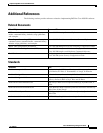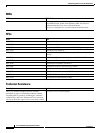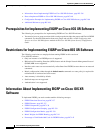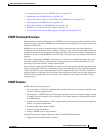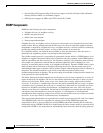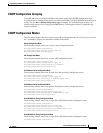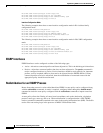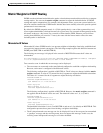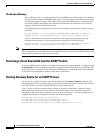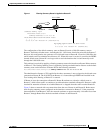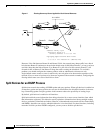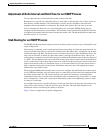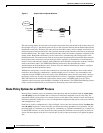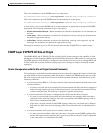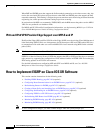
Implementing EIGRP on Cisco IOS XR Software
Information About Implementing EIGRP on Cisco IOS XR Software
RC-141
Cisco IOS XR Routing Configuration Guide
OL-14356-01
Metric Weights for EIGRP Routing
EIGRP uses the minimum bandwidth on the path to a destination network and the total delay to compute
routing metrics. You can use the metric weights command to adjust the default behavior of EIGRP
routing and metric computations. For example, this adjustment allows you to tune system behavior to
allow for satellite transmission. EIGRP metric defaults have been carefully selected to provide optimal
performance in most networks.
By default, the EIGRP composite metric is a 32-bit quantity that is a sum of the segment delays and
lowest segment bandwidth (scaled and inverted) for a given route. For a network of homogeneous media,
this metric reduces to a hop count. For a network of mixed media (FDDI, Ethernet, and serial lines
running from 9600 bits per second to T1 rates), the route with the lowest metric reflects the most
desirable path to a destination.
Mismatched K Values
Mismatched K values (EIGRP metrics) can prevent neighbor relationships from being established and
can negatively impact network convergence. The following example explains this behavior between two
EIGRP peers (ROUTER-A and ROUTER-B).
The following error message is displayed in the console of ROUTER-B because the K values are
mismatched:
RP/0/RP0/CPU0:Mar 13 08:19:55:eigrp[163]:%ROUTING-EIGRP-5-NBRCHANGE:IP-EIGRP(0) 1:Neighbor
11.0.0.20 (GigabitEthernet0/6/0/0) is down: K-value mismatch
Two scenarios occur in which this error message can be displayed:
• The two routers are connected on the same link and configured to establish a neighbor relationship.
However, each router is configured with different K values.
The following configuration is applied to ROUTER-A. The K values are changed with the metric
weights command. A value of 2 is entered for the k1 argument to adjust the bandwidth calculation.
The value of 1 is entered for the k3 argument to adjust the delay calculation.
hostname ROUTER-A!
interface GigabitEthernet0/6/0/0
ipv4 address 10.1.1.1 255.255.255.0
router eigrp 100
metric weights 0 2 0 1 0 0
interface GigabitEthernet0/6/0/0
The following configuration is applied to ROUTER-B. However, the metric weights command is
not applied and the default K values are used. The default K values are 1, 0, 1, 0, and 0.
hostname ROUTER-B!
interface GigabitEthernet0/6/0/1
ipv4 address 10.1.1.2 255.255.255.0
router eigrp 100
interface GigabitEthernet0/6/0/1
The bandwidth calculation is set to 2 on ROUTER-A and set to 1 (by default) on ROUTER-B. This
configuration prevents these peers from forming a neighbor relationship.
• The K-value mismatch error message can also be displayed if one of the two peers has transmitted
a “goodbye” message and the receiving router does not support this message. In this case, the
receiving router interprets this message as a K-value mismatch.



